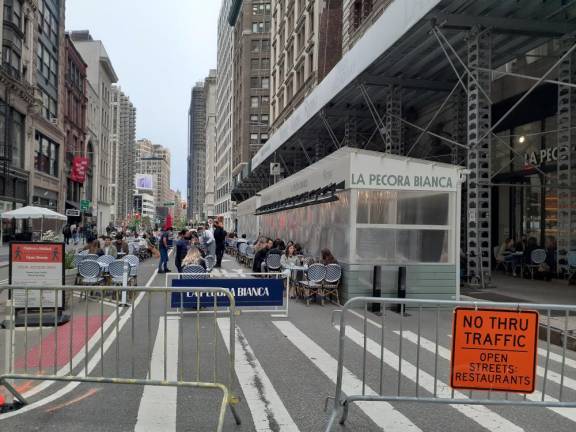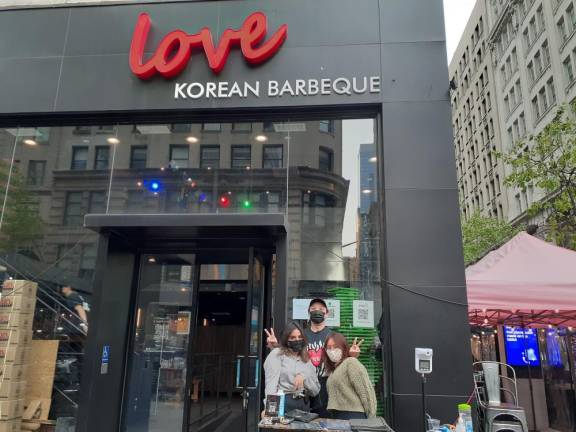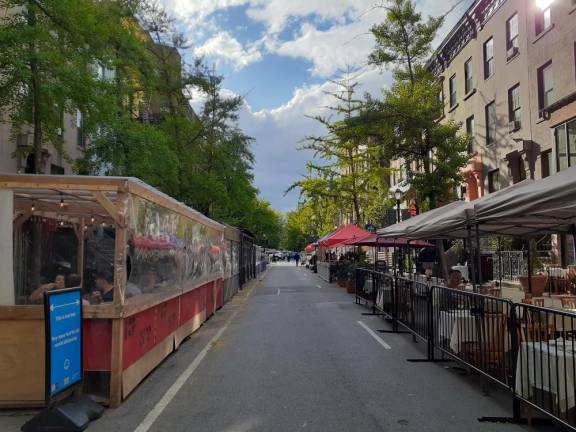Streets of the Future?
The pandemic created Open Streets. New Yorkers embraced them with no plans of letting go



Long before the City Council passed the recent bill making Open Streets a permanent fixture in New York City’s future, restaurant owners were busy building and rebuilding outdoor structures as they gear up for another season of car-free streets and neighborhood bonding. Community organizers meanwhile were meeting and planning how to sustain volunteer efforts that bolster the majority of the programs, while simultaneously fretting about how to fund the various forms of open streets initiatives for “years to come.”
Amid the outdoor hammering and indoor brainstorming, none of the participants contacted ever voiced the option that, now with the pandemic waning and vaccines plentiful, that the program may be winding down.
Writer, professor and urban planning researcher John Surico predicted this.
With a new mayoral race in full swing, he said candidates would doom their chances if they’re going to say to restaurants “’...actually, when I become Mayor, you’re going to have to take down all these structures that you just spent thousands of dollars to put up.’”
He added that, for restaurants to recoup the past year – in terms of revenue – they are going to need 100 percent indoor capacity when the city gets to that point, plus outdoor dining.
“That’s the only way,” he said. “They’re going to have to basically run it at hyper-speed for the next year – combined – to at least start to piece back what they have lost.”
New York City’s Open Streets program is overseen by the city’s Department of Transportation in partnership with community organizations that “allows communities to embrace public space and support small businesses.” Pedestrians and cyclists are given priority to utilize these neighborhood spaces, free of cars.
To date, more than 10,000 restaurants on 87 streets throughout the city have received permits to participate in various combinations of the Open Streets and Open Restaurant programs. While often used interchangeably, the Open Restaurants concept was actually added to the Open Streets program last summer as a form of economic relief to restaurants. This allowed restaurants to create outdoor dining structures constructed on sidewalks and designated, barricaded street locations throughout the five boroughs.
A Year of Mixed Results
Not everyone wants open streets to continue, but the voices of those who want them to remain seem to drown out those who don’t.
“The Open Streets program marks one of the greatest moments in recent memory of the City engaging in a widespread program of tactical urbanism,” claims Manhattan Borough President Gale Brewer, in a March report titled “The Future of Open Streets.” While acknowledging that some programs “have been plagued by different issues” (such as poor volunteer turnout and funding limitations) she says that, overall, “the Open Streets program has been a major success and should continue in perpetuity.”
The annoyed taxi drivers trying to enter Restaurant Row from Ninth Ave at 46th Street in Midtown don’t seem to agree. Within a 15-minute period on a recent Friday afternoon, a uniformed security officer with the Times Square Alliance BID walked in front of the metal barriers to explain to a non-stop line of arguing drivers that the space was closed for the Open Streets program and only visitors to the hotels on the block were allowed in. Most drove off in a huff. The officer said that went on all day long.
At Love Korean Barbecue in Koreatown at 32nd Street and Fifth Avenue, the energized sound of rap music greets passersby as a DJ bops to the beats behind large glass windows. Welcoming diners at a sidewalk table, host, Blanca Bravo and her co-workers were busy with a steady flow of people at dinner time. Love opened on Valentine’s Day last year and had to close a month later because of the pandemic. The additional space has given them a major boost she believes.
“We didn’t have any outdoor [dining] before the pandemic,” Bravo said, “and right now we’re like the most popular restaurant in K-Town.”
Uptown, on spacious Frederick Douglass Blvd in Harlem, the in-demand Southern-style Melba’s Restaurant is gearing up to join other restaurants to take over eight blocks of the major street in late May through the summer as they did last year.
“We get another 30-40 seats outside,” staffer Curtis Davis said, gesturing from the cozy bar toward the busy boulevard. “And now with indoor dining [this year] and outdoor, it’s going to be good.”
As was the original plan of the city – from Chelsea to Downtown, the Village to the Upper West Side and throughout the five boroughs – restaurants, more than other businesses, appear to be benefiting the most financially from the outpouring of people freed to linger for hours on long stretches of car-free roadways. Most commercial strips are managed by community organizations such as the Flatiron 23rd Street Partnership and the Downtown Alliance BIDs which provide a financial cushion and jump-start to quickly staff up for the program.
On predominantly residential blocks, however, there are reports of programs that have already failed because of insufficient volunteer turnout. Each program is responsible for its own fundraising efforts (often through GoFundMe requests) to put on entertainment programs, pay instructors, buy signage and replace stolen barricades (by disgruntled motorists is their guess). The recently passed bill plan to address some of these problems by allocating more funds and resources to underserved areas, even as advocates push for more permanent infrastructure such as pedestrian plazas where it is practical.
What Some Open Streets are Becoming
Over in Brooklyn, on a five-block area of Vanderbilt Avenue in Prospect Heights, the all-volunteer neighborhood program has taken on a life of its own. There are weekend picnics on a popular tree-lined median, musicians and pop-up concerts, and toddlers fully absorbed in their asphalt-drawn creations.
Longtime community organizer Gib Veconi said, while they got in the program to help restaurants survive last year, this year it has evolved into something completely different: a sense of community.
“Human beings are gregarious, we like to be with each other,” he said. “This brings us all on the streets to spend time together. That is what this really achieves.”